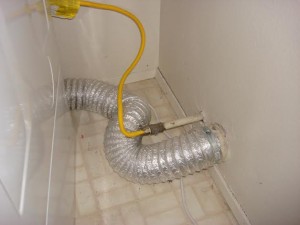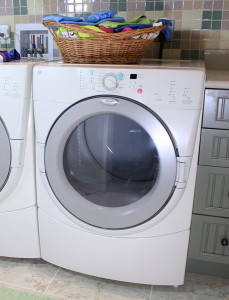Many homeowners don’t realize just how potentially dangerous it is to do laundry. According to the National Fire Protection Association, between 2010 to 2014, there were an estimated 15,970 fires due to washers and dryers in the United States each year. Interestingly, the innocent-looking clothes dryer accounted for 92% of those fires.
These fires resulted in 13 civilian deaths, 440 civilian injuries and $238 million in property damage.
With over 20 years of experience as only one of two women Certified Dryer Exhaust Technicians in California, I know the importance of safety as it relates to dryer vents. Here are important safety-related “Do’s” and “Don’ts” to reduce the chance of dryer fires
Nine Important “Do’s” for Dryer Vents
1) When installing a new dryer, always install a new connector hose between the dryer and the wall. This hose should be a metal connector hose, either rigid or  flexible. If your connector hose is white plastic or vinyl, replace it immediately since those are potential fire hazards. In the case of a flexible hose, the hose should only be long enough to go between the dryer and the wall with a little slack so that if you pull out the dryer, the hose still stays connected to the wall. The Chimney Safety Institute of America (CSIA) recommends that this connector hose never be longer than eight feet. For tight spaces behind the dryer, here is a link for options for dryer vent hoses.
flexible. If your connector hose is white plastic or vinyl, replace it immediately since those are potential fire hazards. In the case of a flexible hose, the hose should only be long enough to go between the dryer and the wall with a little slack so that if you pull out the dryer, the hose still stays connected to the wall. The Chimney Safety Institute of America (CSIA) recommends that this connector hose never be longer than eight feet. For tight spaces behind the dryer, here is a link for options for dryer vent hoses.
2) Always clean out the lint screen before each load. Never use your dryer without the lint screen installed.
3) Using dryer sheets or dryer pads may leave a chemical film on your lint screen, which makes your dryer harder to “breathe.” If you use these products, clean your lint screen using water, liquid soap and a toothbrush every few months.
4) Keep combustible and volatile materials away from your dryer. Paper products like toilet paper and paper towels should not be stored too close to the dryer. In addition, flammable or volatile chemicals such as alcohol, gasoline, motor oil, finishing oils and stains, spot removers, solvents, cleaning agents and cooking oils should not be stored in the laundry room. These chemicals are not only flammable but they can also give off toxic vapors and odors.
5) Always check pockets before you do your laundry. Paper products such as receipts, note paper, or cocktail napkins will get past the lint screen and land inside the dryer under the drum where the paper becomes a fire hazard. Dryer sheets or dryer pads can also get into the vent. Sometimes this paper, along with lint which you have no control over, will get passed from the dryer into the dryer vent where it mixes with moisture from drying your clothes and becomes paper mache inside the vent pipe. This will clog up the vent, creating a potential fire hazard for your dryer.
6) Just because the dryer venting system is clean, doesn’t mean you never have to worry about dryer fires. The lint and paper accumulation inside the dryer under the drum is the fuel that creates the dryer fires. Contact an appliance repair company to periodically have the lint and paper accumulation cleaned out from the body of the dryer, under the drum.
7) Due to the high incidence of dryer fires, an ABC-type fire extinguisher located close to the dryer is highly recommended in a visible and accessible location.
8) In addition to the fire hazard associated with dryer fires, there’s also the issue of carbon monoxide poisoning. Blocked or plugged up dryer vents for gas dryers may allow carbon monoxide to back up into the home. It is highly recommended to install a carbon monoxide detector close to the dryer when you have a gas dryer.
9) Have the dryer vents professionally brushed out on a regular basis. Professionals vary as to the frequency for cleaning out the dryer vents but the CSIA recommends that the dryer vent be checked on an annual basis. Of course, your laundry habits as well as how the dryer venting system is routed will be contributing factors in the frequency of the dryer vent cleaning. To find a qualified Certified Dryer Exhaust Technician in your area, go to www.csia.org. Make sure that the technician uses a brushing method to scrub the vent clean.
Many companies will only use vacuums or air pressure which will simply remove the loose accumulation from the dryer vent which is a waste of your time and money. A professional Dryer Exhaust Technician will also use a Magnehelic Gage or Vane Anemometer to measure the air flow of the dryer vent system after the dryer vent cleaning.
Nine Important “Don’ts” for Dryer Vents
1) Don’t push the dryer too close to the wall behind the clothes dryer. The connector hose should not be kinked or crushed which will reduce air flow. Not only will this create more lint in the dryer but your dryer will run hotter than it needs to, setting you up for a dangerous dryer fire.
2) Don’t close the door to the laundry room or laundry closet when your dryer is on. According to the Uniform Mechanical Code, a dryer needs 100 square inches of “make-up air,” the equivalent of a 10″x10″ window. Without this make-up air, the dryer will run harder and hotter than it needs to. This isn’t good for the dryer and it’s not safe for you.
3) Don’t use the exhaust fan in your laundry room if the dryer is on. The exhaust fan pulls air out of the room, which makes your dryer harder to bring in the make-up air that it needs.
4) Never dry clothes that have flammable or volatile chemicals on them. Instead, dry these clothes outside.
5) Don’t overload your dryer. It makes your dryer run harder and hotter than it needs to. This will create extra wear-and-tear on your dryer as well as expensive dryer repairs, and it will reduce the lifespan of your dryer.
6) Your dryer brings in make-up air from underneath and in front of your dryer. Don’t block this area with baskets of laundry. There should be a minimum of 18″ of open area in front of your dryer.
7) Never dry rubber-backed rugs or bathroom mats or other items with foam, plastic or vinyl materials. Not only does this potentially create a fire hazard, but it’ll ruin the items due to the high heat.
8) Dryers must always vent to the exterior of the house and never into enclosed areas like garages, attics, or crawl spaces. Never use the indoor dryer vent box kits purchased from the big box stores. These are not to code and can be especially dangerous if you’re venting a gas dryer.
9) Lastly and most importantly, NEVER run your dryer if you’re not at home or if you’re asleep. I receive several phone calls a month from people whose dryer caught on fire. You want to be home AND awake in case it does.
Following these tips will reduce the chance of dangerous dryer fires and will keep you worry-free while doing your laundry!


